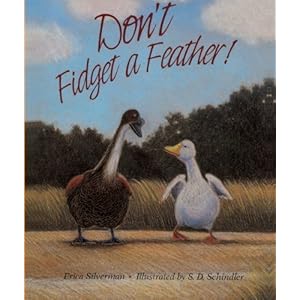TEN FAVORITE PICTURE BOOKS
#pb10for10
 Don't Fidget a Feather by Erica Silverman, illustrated by S.D. Schindler. How far will Goose and Duck go to win their freeze-in-place contest? Who really wins in the end? Is winning more important than other values?
Don't Fidget a Feather by Erica Silverman, illustrated by S.D. Schindler. How far will Goose and Duck go to win their freeze-in-place contest? Who really wins in the end? Is winning more important than other values?Roasted Peanuts by Tim Egan. When Sam is picked for the team but his best friend, Jackson, isn't, the two help each other through, and ultimately Jackson finds his own special talent.
 Else-Marie's Seven Little Daddies by Pija Lindenbaum. Else-Marie worries about her classmates' perceptions of her non-traditional family when her seven small daddies pick her up at school one day. This is a silly story with a serious message about accepting and enjoying families in any form.
Else-Marie's Seven Little Daddies by Pija Lindenbaum. Else-Marie worries about her classmates' perceptions of her non-traditional family when her seven small daddies pick her up at school one day. This is a silly story with a serious message about accepting and enjoying families in any form. The Night I Followed the Dog by Nina Laden. This story reads like a hard-boiled detective book for young children. A boy follows his dog at night and witnesses a surprising world where dogs are masters and they can sit on the couch!
The Night I Followed the Dog by Nina Laden. This story reads like a hard-boiled detective book for young children. A boy follows his dog at night and witnesses a surprising world where dogs are masters and they can sit on the couch! John Henry by Julius Lester, illustrated by Jerry Pinkney. I just love the language. Lester's images are unusual, for example, he describes a mountain "as big as hurt feelings." It's a tall tale and fun, but also serves as a reminder that "dying ain't important...what matters is how well you do your living."
John Henry by Julius Lester, illustrated by Jerry Pinkney. I just love the language. Lester's images are unusual, for example, he describes a mountain "as big as hurt feelings." It's a tall tale and fun, but also serves as a reminder that "dying ain't important...what matters is how well you do your living."  The Colors of Us by Karen Katz. Honey, cinnamon, peanut butter, peaches. When I read this aloud, the children all want to be identified by one of these "colors." This is a celebration of shades of skin that are much more subtle and diverse than simply black, brown, red, yellow or white.
The Colors of Us by Karen Katz. Honey, cinnamon, peanut butter, peaches. When I read this aloud, the children all want to be identified by one of these "colors." This is a celebration of shades of skin that are much more subtle and diverse than simply black, brown, red, yellow or white. The Day Ocean Came to Visit by Diane Wolkstein. This Nigerian folktale explains (...well, I don't want to give it away if you haven't read it!). The personification is fantastic and children are delighted by the resolution.
The Day Ocean Came to Visit by Diane Wolkstein. This Nigerian folktale explains (...well, I don't want to give it away if you haven't read it!). The personification is fantastic and children are delighted by the resolution.And this makes 10!